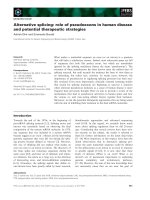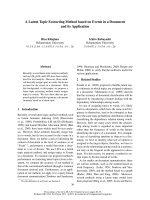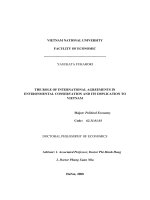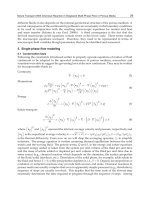Theileriosis in tharparkar calves and its therapeutic management-case study
Bạn đang xem bản rút gọn của tài liệu. Xem và tải ngay bản đầy đủ của tài liệu tại đây (113.47 KB, 3 trang )
Int.J.Curr.Microbiol.App.Sci (2018) 7(8): 3981-3983
International Journal of Current Microbiology and Applied Sciences
ISSN: 2319-7706 Volume 7 Number 08 (2018)
Journal homepage:
Case Study
/>
Theileriosis in Tharparkar Calves and its Therapeutic
Management-Case Study
M.S. Meel*, R.S. Pal, G. Mishra and M. Kajla
Department of Animal Nutrition, College of Veterinary and animal Science, Navania,
Vallabhnagar, Udaipur-333601, Rajasthan, India
*Corresponding author
ABSTRACT
Keywords
Theileria, Calves,
Buparvaquone,
Hyalomma, Anorexia
Article Info
Accepted:
22 July 2018
Available Online:
10 August 2018
Theileria diseases are known to cause heavy losses to the livestock industry. Lack of
appropriate control strategies for this disease lead to increase in mortality, reduced milk
production, lowered animal drought power, ultimately produces constraint to the dairy
industry. Theileriosis is a tick-borne disease, caused by Theileria annulata. The vector
ticks are of the genus Hyalomma. This case report revealed the successful therapeutic
management of theileriosis in Tharparkar calves. Clinical examination of affected calves
revealed high fever (104.50 F to 1060F), dullness, anorexia and enlarged lymph nodes. The
blood smears examination after staining revealed the presence of Theileria organisms.
Buparvaquone along with supportive therapy could cure calves.
Introduction
Theileriosis is caused by T. annulata and is
transmitted through Ixodid tick of genus
Hyalomma anatolicum (Mirzaei, 2007). In
bovine, Tropical Theileriosis occurs in
Mediterranean countries, Middle East, Indian
and China due to infection of T. annulata
(Radostits et al., 2007). Theileriosis is a major
constraint for cattle production in the tropics
and subtropics (Jongejan and Uilenberg,
1994). In India the annual loss reported due to
tropical theileriosis is approximately US$ 800
million (Devendra, 1995). The hot and humid
climate is highly favourable for the
development and survival of ticks. The major
clinical manifestation of theileriosis is higher
body temperature regularly than in any other
cattle disease. Fever from 41 to 42°C is
common in acute stages. Later on (day 5 to
day 10 from the clinical onset), temperature
will lower to a normal range (38.0–39.5°C),
but the disease will continue to progress,
despite a possible apparent clinical
improvement (appetite comes back).
Afterwards, from day 10 to day15, there is a
downfall stage, with hypothermia (37 to
38°C), anemia, jaundice, and heart failure.
Such animals rarely recover, even with
intensive treatment. Lymph nodes are
commonly enlarged and there may be episodes
of blood from the nose, difficulty breathing
and weight loss (Sengupta et al., 2003).
3981
Int.J.Curr.Microbiol.App.Sci (2018) 7(8): 3981-3983
Theileriosis occurs due to infection of variety
of tick vectors and leads to appearance of
infections ranged from clinically in apparent
to rapidly fatal one (Taylor et al., 2007). The
present case report demonstrates the
therapeutic management of theileriosis cases
in calves.
Case History and Observation
Two calves having age between 4-6 months at
Livestock Research Station, Chandan reported
with persistent fever (104.50F and 1060F)
along with enlargement of prescapular lymph
node, oedema of the dependent parts of the
body, weakness, anorexic, lachrymation,
dyspnoea and anaemia. Clinical signs revealed
suspection for haemoprotozoan infection,
blood smear examination from peripheral
circulation revealed presence of Theileria (Fig.
1). Faecal examination was done to rule out
any endoparasitic infestation, results of which
were negative for presence of any egg or
evidence of parasite.
Fig.1 Blood smear
demonstrates the therapeutic management of
theileriosis cases in calves.
Therapeutic management and Discussion
In the present study, the affected calves were
treated with Buparvaquone @ 2.5 mg/kg body
weight intramuscularly and advised to repeat
after seven days (Naik et al., 2010). In
addition, meloxicam @ 0.5 mg/kg body
weight intramuscularly for three days.
Additionally supportive
therapy with
crystalloid
fluid,
iron
preparations,
multivitamin, folic acid and cyanocobalamin
was also done as it can fasten the recovery
rate in Theileria (Singh et al., 2016). The
calves were recovered and attained normal
health after one week of treatment. After two
weeks of treatment animals were further
screened for evidence of infection which was
found negative. The present case report
References
Devendra, C. (1995). In Global Agenda for
Livestock research, EDS, ILRI, Nairobi,
41-48.
Jongejan, F. and Uilenberg, G. (1994). Office
International des Épizooties. 13: 12011226.
Mirzaei, M. (2007). Treatment of natural
tropical theileriosis with the extract of
the plant Peganumharmala. Korean
Journal of Parasitology, 45: 267-271.
Naik, G. Ananda, K. J. and Kavitha, B.
(2010). Theileriosis in calves and its
successful treatment. Veterinary World,
3 (4): 191.
3982
Int.J.Curr.Microbiol.App.Sci (2018) 7(8): 3981-3983
Radostits, O. M., Gay, C. C., Hinchcliff, K.
W. and Constable, P. D. (2007).
Veterinary Medicine: A Textbook of
Diseases of cattle, horses, sheep, pigs,
and goats. 10th ed. Saunders Elsevier,
pp. 1483-1540.
Sengupta, P. P., Bansal, G. C. and Ray, D.
(2003). Ocular lesions in experimental
theileriosis. Journal of Veterinary
Parasitology, 7(2): 127–129.
Singh, A., Srivastava, M., Shah, H. K., Gupta,
K., Tripathi, A. K. and Chaudhary, A.
K. (2016). Mix Infestation of
Trypanosomiasis and Theileriosis in
Buffaloes. Veterinary Practitioner,
17(2): 260.
Taylor, M.A., Coop, R. L. and Wall, R. L.
(2007). Veterinary Parasitology. 3rd ed.
Blackwell Publishing.
How to cite this article:
Meel, M.S., R.S. Pal, G. Mishra and Kajla, M. 2018. Theileriosis in Tharparkar Calves and its
Therapeutic Management – Case Study. Int.J.Curr.Microbiol.App.Sci. 7(08): 3981-3983.
doi: />
3983









